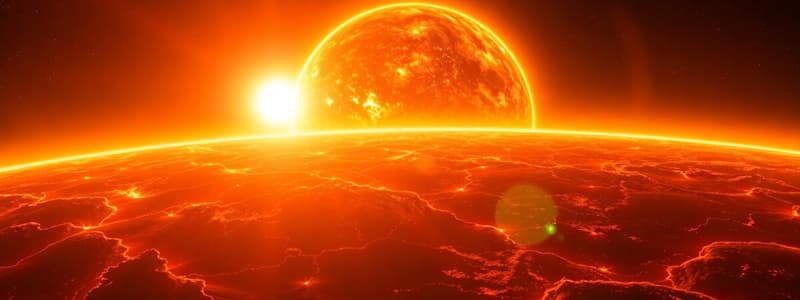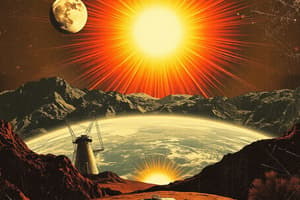Podcast
Questions and Answers
Which of the following best describes the process by which energy generated in the Sun's core reaches the photosphere?
Which of the following best describes the process by which energy generated in the Sun's core reaches the photosphere?
- Energy is conducted through the dense plasma of the Sun's interior layers.
- Energy is primarily transferred through convection currents directly from the core to the photosphere.
- Energy is transported by radiative diffusion through the radiation zone and convection in the convective zone. (correct)
- Energy is immediately released as visible light and travels directly to the photosphere.
What key factor allows nuclear fusion to occur in the Sun's core despite the electrostatic repulsion of hydrogen nuclei?
What key factor allows nuclear fusion to occur in the Sun's core despite the electrostatic repulsion of hydrogen nuclei?
- The presence of neutrinos neutralizing the repulsive forces.
- The extreme temperature and pressure. (correct)
- The strong nuclear force attracting protons.
- The emission of gamma rays.
Why is gravitational equilibrium crucial for maintaining a stable fusion rate in the Sun?
Why is gravitational equilibrium crucial for maintaining a stable fusion rate in the Sun?
- It ensures a uniform distribution of hydrogen throughout the Sun's layers.
- It prevents the Sun from collapsing under its own gravity, maintaining a constant density.
- It acts as a thermostat, adjusting the fusion rate based on temperature changes to balance gravity and pressure. (correct)
- It facilitates the efficient transfer of energy from the core to the outer layers.
Which of the following particles allows scientists to directly study the nuclear reactions occurring in the Sun's core?
Which of the following particles allows scientists to directly study the nuclear reactions occurring in the Sun's core?
What is the primary role of convection in the solar energy transport process?
What is the primary role of convection in the solar energy transport process?
Which of the following best describes the proton-proton chain reaction?
Which of the following best describes the proton-proton chain reaction?
Why do X-ray images primarily show the Sun’s corona rather than its photosphere or convective zone?
Why do X-ray images primarily show the Sun’s corona rather than its photosphere or convective zone?
What role does radiative diffusion play in transporting energy from the Sun's core?
What role does radiative diffusion play in transporting energy from the Sun's core?
Why is it necessary for the temperature to be higher for the fusion of heavier elements compared to hydrogen?
Why is it necessary for the temperature to be higher for the fusion of heavier elements compared to hydrogen?
How do scientists use helioseismology to understand the Sun's interior?
How do scientists use helioseismology to understand the Sun's interior?
What is the sequence of steps (proton-proton chain) that allows hydrogen to fuse to helium?
What is the sequence of steps (proton-proton chain) that allows hydrogen to fuse to helium?
What are solar neutrinos, and why are they important for understanding the Sun’s core?
What are solar neutrinos, and why are they important for understanding the Sun’s core?
What is the key mechanism behind the Sun's natural 'solar thermostat,' which helps maintain a steady core fusion rate?
What is the key mechanism behind the Sun's natural 'solar thermostat,' which helps maintain a steady core fusion rate?
Why has the Sun’s luminosity gradually increased over billions of years?
Why has the Sun’s luminosity gradually increased over billions of years?
In which two main zones does energy generated through fusion travel to the Sun’s surface, and what are their primary modes of energy transport?
In which two main zones does energy generated through fusion travel to the Sun’s surface, and what are their primary modes of energy transport?
How do astronomers validate mathematical models that are used to learn about the Sun’s structure and behavior?
How do astronomers validate mathematical models that are used to learn about the Sun’s structure and behavior?
What role does gravitational contraction play in the Sun, and when was this process most significant?
What role does gravitational contraction play in the Sun, and when was this process most significant?
What two forces are balanced in the Sun's gravitational equilibrium, and what does this balance ensure?
What two forces are balanced in the Sun's gravitational equilibrium, and what does this balance ensure?
Why do sunspots appear darker than the surrounding areas on the Sun's photosphere?
Why do sunspots appear darker than the surrounding areas on the Sun's photosphere?
What happens when the Sun's core temperature rises?
What happens when the Sun's core temperature rises?
Which statement is not true about the Sun?
Which statement is not true about the Sun?
Why must atomic nuclei collide with large amounts of kinetic energy for nuclear fusion to start?
Why must atomic nuclei collide with large amounts of kinetic energy for nuclear fusion to start?
Which causes the most significant increase in the number of sunspots?
Which causes the most significant increase in the number of sunspots?
Why are mathematical models important to our study of the Sun?
Why are mathematical models important to our study of the Sun?
What is a “solar thermostat”?
What is a “solar thermostat”?
Which energy release of the Sun poses a risk to GPS communication?
Which energy release of the Sun poses a risk to GPS communication?
What is the primary composition of particles in the Sun?
What is the primary composition of particles in the Sun?
What determines the Sun's stable luminosity in the long term?
What determines the Sun's stable luminosity in the long term?
How much more massive is the Sun compared to Earth?
How much more massive is the Sun compared to Earth?
What is the average surface temperature of the Sun?
What is the average surface temperature of the Sun?
How much more energy is created from the Sun today compared to the past?
How much more energy is created from the Sun today compared to the past?
Why is the photosphere considered the surface of the Sun?
Why is the photosphere considered the surface of the Sun?
Which best describes the relationship between solar flares, coronal and geomagnetic storms?
Which best describes the relationship between solar flares, coronal and geomagnetic storms?
Where is fusion most prevalent in the Sun?
Where is fusion most prevalent in the Sun?
Which statement describes the composition of the Interstellar Medium (ISM)?
Which statement describes the composition of the Interstellar Medium (ISM)?
Which temperature characterizes molecular clouds?
Which temperature characterizes molecular clouds?
How do scientists use dust to see through far-away objects?
How do scientists use dust to see through far-away objects?
Why are molecular hydrogen and carbon monoxide necessary for forming a star?
Why are molecular hydrogen and carbon monoxide necessary for forming a star?
During the creation of a star, why does not all the heat build up until the star cannot contract?
During the creation of a star, why does not all the heat build up until the star cannot contract?
What are Jeans mass?
What are Jeans mass?
What causes solar flares?
What causes solar flares?
Why does the protostar mass increase over time?
Why does the protostar mass increase over time?
Population III stars are...?
Population III stars are...?
Flashcards
Nuclear fusion in the Sun
Nuclear fusion in the Sun
The core's extreme temperature and density are just right for fusion of hydrogen to make helium
Energy transport in the Sun
Energy transport in the Sun
Energy moves through the Sun via radiative diffusion and convection.
Knowing the Sun's interior
Knowing the Sun's interior
Theoretical models are constructed using physics laws and checked against observations like size, temperature, and energy output. We use solar vibrations and solar neutrinos
Proton-Proton Chain
Proton-Proton Chain
Signup and view all the flashcards
Radiative Zone
Radiative Zone
Signup and view all the flashcards
Convective Zone
Convective Zone
Signup and view all the flashcards
Photosphere
Photosphere
Signup and view all the flashcards
Helioseismology
Helioseismology
Signup and view all the flashcards
Neutrino detection
Neutrino detection
Signup and view all the flashcards
Electrostatic Repulsion
Electrostatic Repulsion
Signup and view all the flashcards
Kinetic Energy
Kinetic Energy
Signup and view all the flashcards
Solar Thermostat
Solar Thermostat
Signup and view all the flashcards
Gradually Brightened Sun
Gradually Brightened Sun
Signup and view all the flashcards
Energy Reaches Sun's Surface
Energy Reaches Sun's Surface
Signup and view all the flashcards
Radiative Zone (Energy Reach)
Radiative Zone (Energy Reach)
Signup and view all the flashcards
Convective Zone (Energy Reach)
Convective Zone (Energy Reach)
Signup and view all the flashcards
Neutrinos
Neutrinos
Signup and view all the flashcards
Apparent Brightness
Apparent Brightness
Signup and view all the flashcards
Color And Temperature
Color And Temperature
Signup and view all the flashcards
Hertzsprung-Russell Diagram
Hertzsprung-Russell Diagram
Signup and view all the flashcards
What does the X-axis show for H-R?
What does the X-axis show for H-R?
Signup and view all the flashcards
OBAFGKM
OBAFGKM
Signup and view all the flashcards
Stellar Distances
Stellar Distances
Signup and view all the flashcards
Stellar Temperatures
Stellar Temperatures
Signup and view all the flashcards
Stellar Masses
Stellar Masses
Signup and view all the flashcards
Two cluster types
Two cluster types
Signup and view all the flashcards
Turnoff Point
Turnoff Point
Signup and view all the flashcards
Why do stars form?
Why do stars form?
Signup and view all the flashcards
Slowing contraction
Slowing contraction
Signup and view all the flashcards
Rotation
Rotation
Signup and view all the flashcards
Nuclear fusion
Nuclear fusion
Signup and view all the flashcards
What's the smallest newborn mass?
What's the smallest newborn mass?
Signup and view all the flashcards
Stars radiate for how long?
Stars radiate for how long?
Signup and view all the flashcards
Tyical Masses?
Tyical Masses?
Signup and view all the flashcards
Molecular Clouds
Molecular Clouds
Signup and view all the flashcards
Thermal Energy
Thermal Energy
Signup and view all the flashcards
Colliding Through Radiation
Colliding Through Radiation
Signup and view all the flashcards
New Clumps Split
New Clumps Split
Signup and view all the flashcards
Why do starts tend to form in clusters?
Why do starts tend to form in clusters?
Signup and view all the flashcards
Contracting Cloud
Contracting Cloud
Signup and view all the flashcards
Study Notes
- Nuclear fusion occurs in the Sun's core, requiring immense pressure and temperatures around 15 million degrees Celsius for hydrogen nuclei (protons) to overcome electrostatic repulsion.
- Via the proton-proton chain, hydrogen nuclei collide and fuse, forming helium and releasing energy as gamma rays.
- Gravitational pressure sustains this process, keeping the core hot and dense enough for continuous fusion.
Energy Transfer
- Energy produced by fusion travels outward through the radiative zone and the convective zone.
- In the radiative zone, energy is transported slowly by absorption and re-emission of photons, taking thousands to millions of years.
- In the convective zone, energy moves more rapidly as hot plasma rises, cools, and sinks, similar to boiling water.
- Finally, energy reaches the photosphere, where it is emitted as visible light and other forms of radiation into space.
Studying the Sun's Interior
- Scientists use helioseismology to analyze vibrations on the Sun's surface, revealing internal structure and movement.
- Neutrino detection confirms nuclear fusion in the core, as these particles escape almost instantly and can be detected on Earth.
- Computer models predict internal processes and confirm the understanding of stellar structure, using physics and observational data.
- Temperatures need to be higher for the fusion of heavier elements.
- Atomic nuclei are positively charged, and electrostatic repulsion increases with more protons.
- Overcoming repulsion needs greater force, hence higher temperatures, for sufficient kinetic energy.
- Helium nucleus with 2 protons and 2 neutrons has greatest mass.
- Mass is converted into energy when they form helium, making nucleus less massive.
- X-ray images of the Sun generally show the corona.
- X-rays are emitted by hot, high-energy plasma in the corona, reaching millions of degrees.
- The coolest layer of the Sun is the photosphere, with a temperature of about 5,500°C (10,000°F).
- Scientists estimate the central temperature of the Sun through mathematical models.
- These models incorporate physics equations describing nuclear fusion, pressure, and energy transfer.
- Central temperature around 15 million degrees Celsius.
- Sunspots appear darker because they are cooler than their surroundings.
- Intense magnetic activity suppresses convection.
- Temperatures approximately 3,000-4,500°C.
Fusion Products
- At the center of the Sun, fusion converts hydrogen into helium, energy, and solar neutrinos.
- via the proton-proton chain, hydrogen nuclei (protons) fuse, forming helium and releasing energy in gamma rays.
- Solar energy leaves the core of the Sun as photons.
- Observing neutrinos offers direct evidence of fusion in the Sun's core.
- The cycle of solar activity is caused by changes in the organization of the Sun's magnetic field.
- Occurs on an 11-year cycle, leading to fluctuations in sunspots, solar flares, and coronal mass ejections
- Particles from the Sun pose the greatest hazard to communication satellites
- High-energy charged particles from solar storms can damage satellites and affect GPS.
- Gravitational contraction generates energy by causing a gas cloud to collapse under its own gravity, which increases pressure and temperature.
- This process was important in the Sun's history.
- It happened before nuclear fusion began.
Gravitational Equilibrium
- In gravitational equilibrium, outward pressure from nuclear fusion balances the inward pull of gravity.
- The Sun is in energy balance, meaning generated energy equals energy radiated away, ensuring stable luminosity.
- Luminosity: Approximately 3.8 × 10^26 watts, equivalent to 4 trillion 100-watt light bulbs per person on Earth.
- Mass: Approximately 2 × 10^30 kilograms, or 330,000 times Earth's mass.
- Radius: Approximately 700,000 kilometers, allowing over 100 Earths across its diameter.
- Surface Temperature: Around 5,500°C (10,000°F), enough to melt any known substance.
- Core: The hottest, densest part of the Sun where nuclear fusion occurs.
- Radiative Zone: Energy transports outward via absorbed and re-emitted photons; process taking thousands to millions of years.
- Convective Zone: Energy is carried by rising/falling hot gas, similar to boiling water.
- Photosphere: The visible surface of the Sun where light escapes.
- Chromosphere: Thin layer above the photosphere emitting ultraviolet light.
- Corona: The Sun's outermost layer that extends millions of kilometers, and emits X-rays.
- Nuclear fission- a heavy nucleus is split, it occurs in nuclear power plants.
- Nuclear fusion - smaller nuclei combine, it takes place in the Sun.
- High temperatures and pressures are required for nuclear fusion.
- Atomic nuclei are positively charged and repel each other.
Proton-proton Chain
- The overall reaction in the Sun.
- 4 hydrogen nuclei (protons) result in 1 helium nucleus, + energy + neutrinos,
- The steps is:
- Two protons fuse forming deuterium, releasing positron and neutrino.
- Another proton collides with deuterium forming helium-3.
- Two helium-3 nuclei collide forming helium-4 and releasing two extra protons.
- This process releases energy in the form of gamma rays.
- If the core temperature rises, fusion occurs faster, increasing energy output.
- If the core temperature drops, fusion occurs slower, causing the Sun to contract slightly under gravity, which increases the temperature and speeds up fusion.
- Over time hydrogen is fused into helium, the core becomes more helium-rich and contracts under gravity, making it slowly get brighter
- Energy moves outward in two main stages: Radiative Zone - Energy transferred by photons. Convective Zone - Energy is carried by convection.
- Mathematical models allow testing by comparing it to observations like helioseismology.
- Neutrinos nearly massless, neutral particles. Pass through matter, making them hard to detect.
- Solar neutrino problem - early neutrino detectors measured only ⅓ of them
- Now, scientists discovered that neutrinos can change "flavors".
- Before Einstein, gravitational contraction was a plausible mechanism for solar energy.
Core Conditions
- Temperature rise in the Sun's core is natural solar thermostat effect.
- Fusion in the solar core were to cease would not immediately grow dimmer due to radiation
- Magnetic fields cannot be directly photographed.
- Neutrinos rarely interact with any matter so a lead vest would not protect from it.
- few sunspots this year suggests more are coming in five years and more are expected
- Magnetic activity follows a 11 year old solar cycle.
- Solar flares indicates concern among communication.
- It can disrupt satellites, GPS systems, and power grids.
- Neutrinos provide a real-time look at fusion in the Sun's core.
- Sunspots are regions are inhibition so there would be no sunspots on the Sun
- Scientists do not design telescopes to observe fusion reactions in the Sun.
Stellar Luminosities
- Stellar or total measure via bright distance; via measurements like parallax; by observing
- stellar temperatures depends on color and type of spectral
- Stellar masses are measured in binary systems; measured by shifts in their light due to the Doppler effect.
- Open clusters have loosely bound groups of young stars and found in galactic disk/are young
- Globular Clusters - collections packed and found in thegalactic halo
- age is measured by examining its Hertzsprung-Russell diagram
- Comparing models, astronomers are able to estimate and determine the clusters age Hertzsprung - Shows Luminosity, temp, shows groups incl Main Seq, giants, dwarfs
Main Sequence
- The main region stars stay for time hydrogen and helium; deter,oned my mass/the luminositiy and how giant or dwarf they are
Giants
- Exhusted hydrogen in there cores and have heavily elolving elemnts such as supernovae and dwarf
- Variations are due to size; the stars luminosity changes the binary system
- Star A that is luminous is brighter for eart due to dust from Earth
Studying That Suits You
Use AI to generate personalized quizzes and flashcards to suit your learning preferences.




